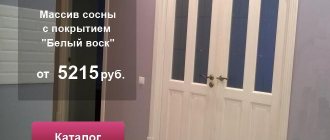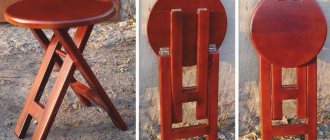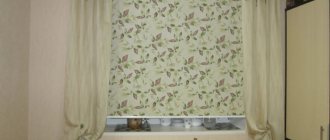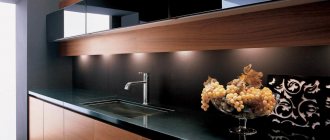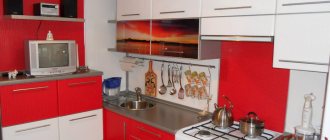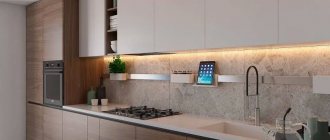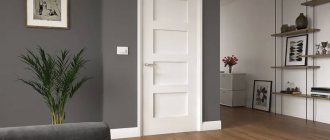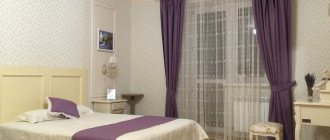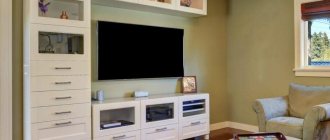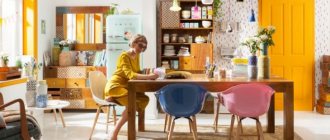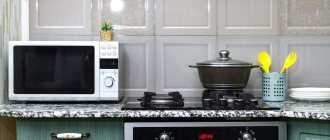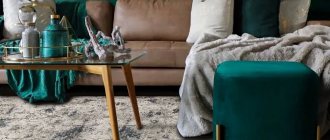16.05.2018 0
5552
Veneer and its variety eco-veneer are modern materials used in furniture production to create cabinets and other cabinet furniture. Products made from them are durable, and thanks to their beautiful design and high-quality workmanship, they are aesthetically pleasing. It is the attractiveness, naturalness and practicality that contributed to the popularity of using veneered furniture in the kitchen interior, which has become an affordable alternative to sets made from natural solid wood.
What is eco-veneer and why is it good?
Published: 05/05/2017,
Eco-veneer is a modern pressed material containing wood fibers bonded with a polymer substance. You can learn about the production features, as well as the advantages and disadvantages of this material from this article.
If you like the look of natural wooden surfaces, but at the same time you do not want to spend a significant amount of money on products made of natural wood, or consider it irrational due to the presence of pets or children who can spoil or scratch expensive purchases, the ideal solution for you would be to purchase furniture products made from modern material – eco-veneer. Unlike conventional veneer, which consists of thin sheets of wood, eco-veneer, in addition to natural wood, contains synthetic additives.
Photos of kitchen units finished with veneer
<
>
A set with veneered fronts is not only not inferior to a set made of natural wood in appearance and performance properties, but is also a more practical and reasonable option for the kitchen.
How eco-veneer is produced
The production technology of this material is called CPL, which stands for Continuous Pressure Laminates, and means production using a continuous press. At the initial stage, thin wood fibers are uniformly dyed, which are then glued together and subjected to prolonged pressing on a special two-belt press. During the pressing process, a constant temperature and humidity are maintained in the room, and the duration of the procedure ensures ideal homogeneity of the material, preventing air or gas inclusions.
This technology makes it possible to produce single-color products that imitate various types of natural wood in different shades. The structure of the material with a three-dimensional optical effect (3D eco-veneer) is externally indistinguishable from natural wood; small differences are noticeable only to the touch. A person inexperienced in choosing a material may not even notice the difference between natural wood and its more budget-friendly counterpart. However, unlike pure wood, eco-veneer allows you to use the entire palette of colors and shades, thereby increasing the possibilities for interior design using furniture made from this material.
Kinds
There are 5 different types of eco-veneer. Each of them is an environmentally friendly material, the production of which takes place at the factory in accordance with established standards. Visually, all types of bioveneer are no different. The difference lies only in the properties of the coating.
PVC based
Polyvinyl chloride is a plastic material that resembles plastic without dyes. The necessary dyes and sealants are added to it. The melting point is 66 °C, and at a frost of -15 °C it becomes brittle.
When making Euro veneer for doors, PVC is used that does not emit any toxic substances and is safe for human life and well-being. PVC film is applied to the doors using a vacuum. The surface is carefully sanded, then covered with polyvinyl chloride and placed in a special chamber with high temperature. Thanks to this method, the film is firmly fixed and it becomes impossible to tear it off.
Advantages and disadvantages of eco-veneer
Eco-veneer is a universal material with many positive qualities. Judging by the reviews, it has excellent performance characteristics. Resistance to mechanical damage allows the surface not to be scratched, abraded, or cracked over time. The material tolerates temperature changes and high humidity well, which, for example, allows you to use interior doors made of eco-veneer in bathrooms and toilets without worrying about their condition. Long-term exposure to sunlight does not lead to fading of the surface, which will allow a kitchen set installed on the sunny side not to lose its attractiveness over time.
The material is completely environmentally friendly, does not produce any emissions or odors, and is therefore absolutely safe for humans. When choosing children's furniture made from this material, you do not have to worry about the health of your children. The lightness of the structures greatly facilitates the process of unloading and installing various furniture elements. And of course, one cannot help but note the low cost of products compared to analogues made from natural veneer or solid wood. With high durability, the material does not require special care or renewal of protective coatings. If necessary, you can wipe the surfaces with a damp cloth or use detergents.
Like any material, eco-veneer is not without its drawbacks. The downside of the lightness of the material is its low strength, which is significantly lower than that of solid wood. It is of course difficult to accidentally damage eco-veneer products, but in the event of a targeted blow and shock, the structure may not withstand it. In addition, in the event of significant mechanical damage, repair or restoration is incredibly difficult, and the product will most likely become unusable. Interior doors made of eco-veneer do not have as good sound insulation as solid wood or natural veneer. Therefore, if this indicator is important to you, it is better to refuse such a purchase. Also, the use of a synthetic composition in production interferes with free air exchange, so the room will have to be ventilated more often or equipped with an air conditioning system.
Eco-veneer based on cellulose
Laminate or finishing film - textured paper with a pattern and wood color applied to it, applied to MDF (hardboard). 3D paper is impregnated with special natural melamine resins, which increase its density and protect the coating from mechanical damage and moisture. The material is simply applied and does not require the use of expensive technologies and adhesives. Of all the varieties of eco-veneer, finishing film is the most inexpensive coating. It is mainly used to cover doors in the economy segment, frame structures with honeycomb filling. Such doors are called laminated, they are: plain, 3D with wood texture.
Characteristics of doors covered with finishing film
Advantages:
- Relative cheapness;
- Large selection of various textures and shades;
- The coating is not exposed to ultraviolet radiation and does not fade;
- Safe for health.
- Flaws:
- Of all the coatings, laminate has the worst wear resistance;
- The coating does not protect the canvas from moisture;
- Small thickness.
Application of eco-veneer
This material is often used in the manufacture of various furniture, kitchen sets and interior doors. Eco-veneer is more often used as a cladding material for frames made of solid wood or MDF boards. Due to the frame made of natural materials, the structures have sufficient strength, and the non-susceptibility of eco-veneer to external influences ensures high durability. If handled correctly, doors or kitchens made from this material will last for decades. Assessing the totality of the pros and cons of eco-veneer, we can conclude that it is a worthy alternative to products made from pure wood, and at the same time allows you to save significantly when buying furniture or doors.
Source: www.mebelminsk.by
Kitchen facades made of MDF: film, enamel, plastic or veneer. Which coating should you choose?
A common solution for kitchen furniture today is chipboard cabinets and MDF facades. There are several types of decorative layer that cover MDF facades. Their features must be taken into account when choosing furniture for the kitchen.
1. MDF facades covered with film This coating is obtained by applying PVC film to an MDF board. A large selection of colors, patterns and textures - with marble or wood stylization - and a relatively low price determine the popularity of this option. In addition, the facade covered with PVC film is not afraid of moisture, sunlight and is reliably protected from dirt.
The option of film facades will be economical in terms of the total cost of the kit and unpretentious in terms of maintenance - it is easy to clean with ordinary detergents, but without the use of abrasives.
But such facades also have a significant disadvantage, which is important to know about when buying furniture for the kitchen - at high temperatures, the film can peel off, and if there is mechanical damage, it will no longer be possible to restore the facade; you will have to replace it completely.
2. MDF facades coated with paint Coating facades with enamel and varnish will cost more than film. The choice of bright colors here is almost unlimited, so finding a suitable solution will not be difficult. In case of mechanical damage, such a facade can be restored.
Veneer kitchens: features, varieties and interesting examples
join the discussion
Share with your friends
Nowadays, veneered facades in the kitchen are becoming increasingly popular. This is not surprising, because they look like real wood, smell like wood and even feel the same as wood. At the same time, the cost of the panels is very affordable and affordable for most of our compatriots.
Veneered facades in the kitchen: appearance
Don’t think that veneered kitchens are boring and unoriginal. Veneer comes in different colors and patterns. It can be matte or glossy, depending on the type of varnish. By the way, varnishing creates additional protection - such facades become even more reliable and durable. Here is an example of varnished veneered facades - matte nature kitchen and glossy “energy palisander” from the Kuchenberg company:
Natura kitchen: silky matt lacquer
Kitchen Palisander: glossy varnish
Veneered facades are often combined with others - for example, with enamel or film. In this case, elements with veneer are located in areas subject to the greatest loads. As a rule, this is the lower level of the headset.
Material Eco-veneer. Pros, cons, features
There are a huge number of different names on the modern building materials market. An alternative to natural veneer is the so-called Eco-veneer. Wikipedia says that eco-veneer is a technological multilayer material of the new generation CPL (means “Continuous Pressure Laminates”, that is, subjected to prolonged pressing), which is obtained from wood fibers and a synthetic binder.
Eco-veneer is a modern building material, which was invented thanks to advanced European technologies. It almost identically repeats the relief and color of real wood (ash, cherry, alder, walnut, beech, oak and others).
Great for people who have pets or small children in their homes, who can quickly damage doors made of natural wood or veneer. And also for those who are looking for a less expensive option for the interior, namely doors. Often they can be half the price of veneered ones.
The main difference from natural veneer, and I would say an advantage, is the absence of knots. The basis for eco-veneer is wood fibers obtained from recycled materials generated during wood processing. Due to the fact that all its fibers are dyed separately, the finished canvases from different batches do not differ in color from each other, are absolutely identical in their color parameters to various wood species, and this also allows you to create exactly the color that the customer preferred.
Polypropylene is what glues the colored fibers together; it is a special synthetic resin that is completely safe for people, even with some severe allergies. This substance has long been used in the pharmaceutical, medical and food industries, which can indicate its harmlessness.
Eco-veneer is supplied to enterprises in the form of rolls. After all, when produced in pressing machines, it comes out in the form of rolls, in which there are no air layers and gas inclusions, this has a positive effect on the flexibility and elasticity of this material.
Advantages of doors made from eco-veneer
- The environmental friendliness of the material, confirmed by a special certificate, allows it to be used even in children's institutions;
- High abrasion resistance guarantees long service life of the doors;
- Low cost of products;
- The material quite reliably imitates natural veneer;
- Artificial veneer can withstand sudden changes in temperature and humidity without causing cracks or cracks;
- The material is scratch and chip resistant;
- Eco-veneer is not subject to fading even when exposed to direct sunlight;
- Easy care of products using any detergents.
Comparison of eco-veneer with solid wood
| Array | Eco-veneer | |
| price | high | available |
| decors | limited | unlimited |
| shades | present | none |
| weight | heavy | average |
| strength | strong | average |
| humidity | unstable | stable |
| difference t | unstable | stable |
| burnout | unstable | stable |
| high t | stable | unstable |
| scratches | fears | stable |
| term | for a long time | fast |
| cleaning | wet | wet |
| safety | full | full |
| add. elements | range | range |
- home
- Materials
- Kitchens to order: façade options
- Film
- Kitchens with eco-veneer facades
→
→
→
→
Disadvantages of the purchase
- Low level of strength compared to doors made of natural solid wood. Of course, they won’t withstand Conor McGregor’s blow, but for ordinary home life they are fine;
- In case of serious damage, such a door cannot be repaired, so the leaf will have to be completely replaced;
- Insufficient level of air exchange between rooms, since eco-veneer doors are as dense as possible and do not contain cracks;
- Insufficient level of sound insulation for lovers of complete silence, as well as a low ability to retain heat;
- The weight of such doors becomes a frequent reason for their failure (since they are easy to “slam”). Therefore, we advise you to install automatic door closers or forget about the habit of slamming doors.
Conclusion
Eco-veneer doors are one of the best and optimal door options for the entire apartment. Beautiful, high quality, wood-look, inexpensive, what else do you need? Durability is at the same level, an abundance of colors and design options, you can always choose an analogue for a broken door, without disturbing the design ensemble of your home. At the same time, they suit any interior, be it classic or hi-tech.
Such doors have a very presentable appearance, so they can be installed not only in residential premises, but also in offices. And due to the absence of chloride in the material, it received the prefix “eco” in its name.
In addition, these doors are manufactured without an edge, which makes it possible to completely cover the door parts and eliminate peeling of the eco-veneer. Doors made from this modern building material are suitable for installation between rooms, as well as in bathrooms and balconies.
Source: 169.ru
Solid wood: natural, expensive, outdated
Solid wood doors are rarely found in Belarusian apartments. Wood is valued for its presentable appearance, naturalness and durability, but the high price of this material does not allow it to pave the way to the wallets of the vast majority of compatriots. Doors are made from various types of wood, each of them has its own characteristics and price range.
The most widely used doors in our country are solid pine doors. They are relatively inexpensive, but at the same time quite soft - they scratch easily and are prone to dents. If there are small children in the apartment, this is not the best option. Due to its low density, pine does not tolerate high humidity and temperature changes. It is better not to install such doors in the bathroom or kitchen, and especially in an unheated country house.
— Previously, there were quite a lot of complaints about solid pine doors. Cheap furniture panels were bent, and resin began to ooze out somewhere. It happened that out of 10 doors taken from a warehouse, 3-4 had to be taken back due to various defects. Now there are significantly fewer defects, because wood processing technologies are improving every year, and manufacturers value their reputation, says Mikhail Luchina, director. — In general, with price and quality, not everything is so simple. The cost of solid pine doors can vary significantly. There are manufacturers of standard doors made from cheap solid wood, they use budget furniture panels of the first or second grade (with knots, non-uniform color surface), and there are manufacturers of premium doors - they will have higher quality raw materials, and expensive impregnations, and some decorative elements. Such a door will last a long time, will not swell, will not dry out and will not change its color over the years.
In second place in popularity is alder. It is more durable and resists moisture more confidently, but it also costs more than pine. Oak, beech and mahogany already belong to the premium segment.
Eco-veneer kitchens
Order an estimate before April 20 and receive a discount coupon from RUB 45,000. to buy a kitchen.
Directions to the station metro station “Varshavskaya”
Then walk 5 minutes towards the area.
And you are there! Welcome!
Directions from the station Subway Kuzminki":
by ground transport to the stop “Volgogradsky Prospekt, 163” (3 stops) Buses: 471, 89, 99, 143.143k, 159.169, 655, 491, 551, 551k
Directions from the station metro station "Vykhino":
by ground transport to the stop “Volgogradsky Prospekt, 163”
Buses: 143, 159, 551
Directions from the station metro station "Volzhskaya":
by ground transport to the stop “Volgogradsky Prospekt, 163” (11 stops)
Buses: 551, 551k
And you are there! Welcome!
The GRAND furniture shopping complex is located on the left side of the Leningradskoye Highway when driving into the region, 100 meters from the Moscow Ring Road.
If you travel by public transport:
from the Rechnoy Vokzal metro station to the Butakovo stop:
buses: No. 342, 370, 443, 482, 851
minibuses: No. 342, 443, 532, 662, 949, 986
from the Planernaya metro station to the Butakovo stop: buses: No. 817, 865
minibus: No. 154, 948.
Entrance to shopping complex No. 1, then straight along the escalator to the second floor, after the escalator turn right, 50 meters in a straight line to the end of the hall and then right again.
And you are there! Welcome!
Directions to the station metro stations “Profsoyuznaya”, “Nakhimovsky Prospekt”, “New Cheryomushki” The design and interior center “Expostroy on Nakhimovsky” is located at the intersection of Nakhimovsky and Sevastopolsky avenues. If you travel by public transport: from the Nakhimovsky Prospekt metro station to the Sevastopolsky Prospekt stop, buses: No. 219,908,487 trolleybus: No. 52
from the metro station "Profsoyuznaya" to the stop "Sevastopolsky Prospekt" buses: No. 219,908,44 trolleybus: No. 52
Entrance to Pavilion No. 1, then straight ahead for 15 meters, turn right, then up the stairs to the second floor. And you are there! Welcome!
Directions to the station metro station “Rumyantsevo”
The metro station exit is located on the territory of the Rumyantsevo Business Park.
You are there! Welcome!
Directions to the station :
Myakinino metro station - the station is located on the territory of Crocus City, a free bus runs on the territory from the Myakinino metro station to the shopping center YOUR HOUSE and back. Tushinskaya metro station - bus No. 631, 640, minibus No. 450, 631 to the stop “St. Isakovsky" metro station Shchukinskaya - bus No. 687 to the stop "Department of Labor and Employment"; auto No. 631 to the stop. “St. Isakovsky" metro station Strogino - bus No. 631.736 to the stop "Ul. Isakovsky”, bus No. 652 to the stop. “Department of Labor and Employment”, route taxi No. 310 to the stop “Ul. Isakovsky" metro station Molodezhnaya - minibus No. 10, 10A, 441 to the stop "Ul. Isakovsky"
And you are there! Welcome!
from Myakinino metro station there is a free bus to the hypermarket “Your House on Novorizhskoe Shosse”
Entrance to the shopping complex from the highway to the ground floor, then take the escalator to the first floor, immediately after the escalator to the right to the elevator, then take the elevator to the third floor.
And you are there! Welcome!
A kitchen made from eco-veneer looks beautiful and is inexpensive. Moreover, it has excellent performance characteristics.
Eco-veneer is a multilayer polymer. It is used as a decorative and protective coating for the base material. MDF is usually used as the latter. Its thickness is greater than that of PVC film, therefore its flexibility is worse. Therefore, they cover flat or framed facades with it; it is not suitable for paneled ones.
Due to its sufficient thickness, eco-veneer imitates solid wood (Primavera) in texture. But, since this is an artificial material, it can be painted in any color (Arera), not necessarily in the natural tones of natural wood. The surface can be matte or glossy.
Advantages and disadvantages
- Eco-veneer is noticeably cheaper not only than solid wood, but also natural veneer.
- Furniture made from this material looks beautiful and dignified.
- Eco-veneer does not like things that are too hot, but it can withstand temperature changes without problems.
- This coating is not sensitive to moisture. It does not absorb dirt and is easy to clean.
- Eco-veneer is strong and durable. It is difficult to scratch and is not subject to aging.
- This is a material harmless to humans. It does not emit harmful substances and does not interact with household chemicals.
Furniture manufacture
The furniture frame is made of MDF, which is small sawdust compressed under high pressure. It is then covered with veneer, creating the illusion of solid wood. Ready-made kitchens made of MDF and veneer are finished with varnish or special enamel.
Several materials can be used to finish MDF frames, as can be seen in the photo. An interesting combination is veneer with plastic or white frosted glass, which is used in many modern kitchen interior styles.
Design
Among the stylistic directions in which kitchens are made from eco-veneer, the most common are the following:
- Classical. Plastic is painted only in natural colors, imitating natural wood. Gloss is not desirable; matte doors look more solid.
- Provence. The set “to resemble the French countryside” can be painted. It is best to use marine and pastel colors with a matte surface. The paint does not have to be translucent so that the texture is visible. You can make it more dense.
- Modern. Here, painted plastic is often combined with imitation solid wood. Shiny gloss is quite appropriate, along with matte facades.
- Loft. The module doors are only matte, the design is simpler. It is best if they reproduce textured wood, with a pronounced pattern. The principle of rough natural surfaces is respected by precise selection of colors.
- Techno. Here, facades with a uniform structure, both wood and other colors, are desirable. A pronounced texture is not required. Surfaces are better glossy to enhance the impression of light reflection.
The eco-veneer set is suitable for any kitchen - large, medium or small.
Source: fkm-anons.ru
Eco-veneer: description of the material, features and characteristics, selection criteria
Relatively recently, eco-veneer began to be used in the furniture industry and construction.
Thanks to its qualities and characteristics, the material has gained the trust and popularity of consumers in a short period of time. It is often used for cladding doors, when decorating stairs and other surfaces, as it performs quite well in operation.
Furniture and doors made from the material will last a long time, as evidenced by consumer reviews.
Description of the eco-veneer material
Eco-veneer is a sheet facing material made from polypropylene and wood fibers. Excipients that are safe for human health are used to bind the composition. Unlike similar products, it does not contain chlorides or other harmful components, which is why the prefix “eco” was formed in the name. Wear resistance is achieved thanks to the properties of polypropylene.
The surface of the sheet exactly copies the wood texture. The only thing that can give away an artificial material is the absence of knots on the canvases. It is difficult for an ordinary person to distinguish natural wood from eco-veneer.
The color palette follows the natural shades of tree species. This plays an important role in creating interesting design solutions and sophistication in the interior.
What is natural veneer?
The material is made from various types of wood.
Most often, oak, walnut and tropical plants are used for production. That is why the texture of finished products directly depends on the appearance of the raw materials. In this case, the surfaces are painted using paints and varnishes - in this way they are given the necessary shade.
Natural veneer is thin sheets of wood. The thickness of the products varies from 0.5 mm to 10 mm. During the production of interior doors, sheets are glued to their surfaces. Sheets are obtained in three main ways: sawing, planing, peeling:
- During planing, thin strips are created. Wide workpieces are taken for processing. The finished sheets have an original texture. Pine, ash, and oak are mainly processed in this way.
- During the peeling process, the veneer is removed from a thick log in a spiral. The workpiece is placed in the machine. The log rotates at a constant speed, and a special knife, which is directed towards the center of the tree, removes a thin layer. For example, Karelian birch and maple are processed in this way.
- During the sawing process, logs are cut into thin sheets that are used to decorate doors and furniture. This is the oldest method of producing veneer.
Features and characteristics of eco-veneer
The current trend in the development of the construction and finishing materials market is aimed at a product characterized by high aesthetics, good performance and an affordable price. Eco-veneer fully meets these requirements. Among the characteristics and properties of the material, the following stand out:
• high degree of wear resistance;
• resistance to temperature changes;
• durable structure withstands mechanical stress;
• the absence of harmful additives makes veneer products hypoallergenic and safe;
• moisture resistance allows use in rooms with high humidity levels;
• no special means or technologies are needed for care;
• products have a long service life;
• the ability to choose a color and shade that suits the interior;
• affordable price allows people with different incomes to use veneer.
How to choose eco-veneer products?
The material is mainly used in the production of furniture and doors. Before choosing, you need to familiarize yourself with its characteristics. This will help you find the differences between laminated sheets and eco-veneer on your own. You should go shopping to a specialized store, where if any questions arise, the product can be exchanged. When choosing, you should inspect the integrity of the canvas, the absence of streaks, scratches and stains. It is recommended to trust a well-known manufacturer, since the policy of conquering the market of large companies is characterized by high quality and the use of new technologies in production.
Wood or polypropylene
When choosing sets, buyers are interested in how kitchens made from eco-veneer differ from ordinary ones. Veneer is thin plates obtained by peeling from a piece of wood. The surface retains the pattern of the species used, suitable for lovers of eco-style, minimalism, country, and chalets. But many buyers prefer facades lined with eco-veneer. Polypropylene film with a multilayer structure made kitchen sets light and affordable. The prefix “eco” indicates the safety of the material; it is also used in the production of reusable tableware and food containers.
Production
Finishing sheets are produced from painted wood chips by squeezing out air using a press and high temperatures. Multi-layering gives the material rigidity, the sheets are light, and the pattern imitates the pattern of different rocks. When heated, the film becomes plastic, fits tightly, enveloping every protrusion and recess. This makes it easier to finish shaped front surfaces. The decorated base is finally varnished. It provides additional protection against moisture and scratches. The thickness of eco-veneer suggests its use for framed, smooth facades.
The film coating technology is similar, but the finishing materials are different. The propylene veneer is dense, the embossing is deep, repeating the pores of the solid wood.
